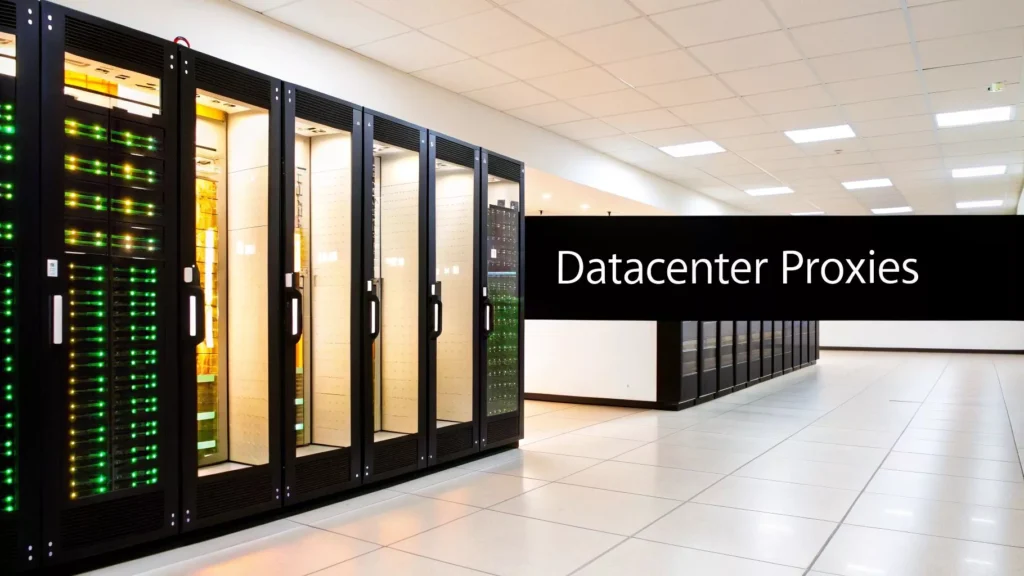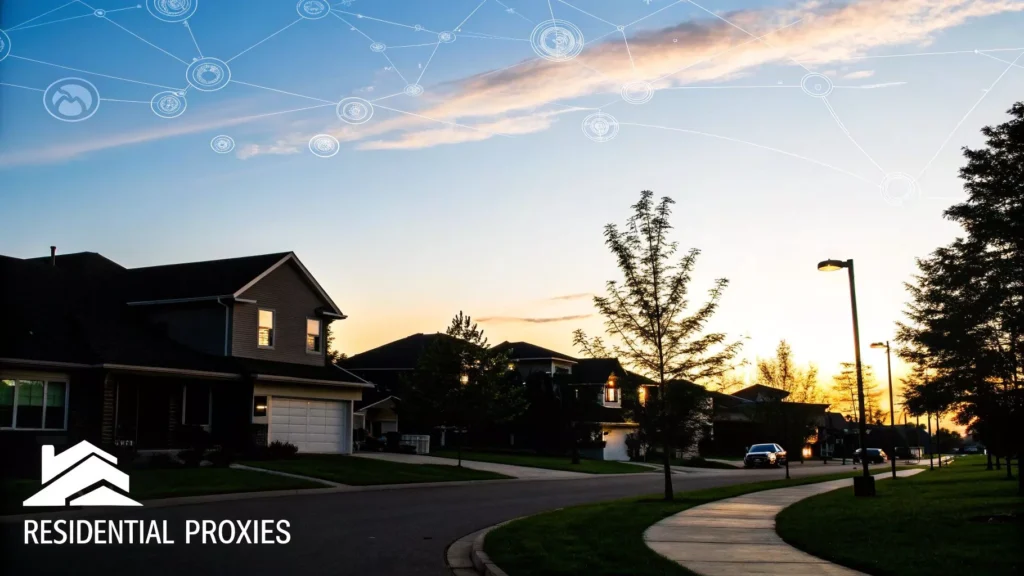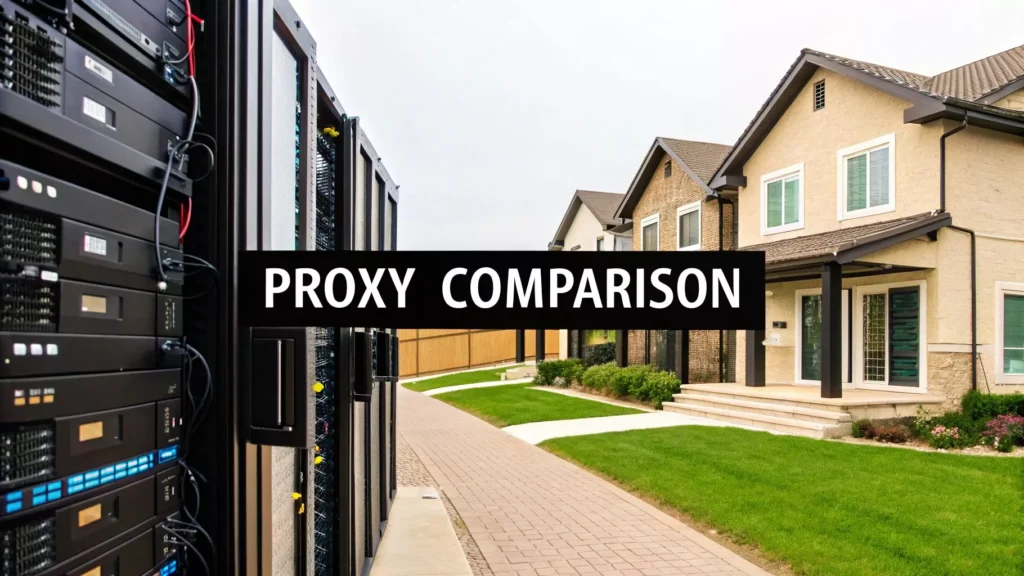The real difference between datacenter and residential proxies boils down to one simple thing: where their IP addresses come from.
Datacenter proxies are artificial IPs generated in a cloud server, which makes them blazing fast but also pretty easy for websites to spot. On the other hand, residential proxies use genuine IP addresses assigned by real Internet Service Providers (ISPs), letting them blend in as regular, everyday users.
Understanding the Core Proxy Differences
When you pick a proxy, you’re essentially choosing a digital disguise. That choice is critical and can make or break whatever you’re trying to do online, whether it’s scraping data, doing market research, or managing multiple accounts. The source of the IP address dictates everything—speed, cost, and most importantly, your risk of getting blocked.

Here’s a practical way to think about it. A datacenter proxy is like a fleet of identical, commercially-registered delivery trucks. They’re fast and you can get a lot of them, but they stick out like a sore thumb in a quiet residential neighborhood. A residential proxy is like a collection of different, privately-owned cars—they blend in perfectly because they look like they belong there. One gets the job done with brute force; the other with stealth.
Datacenter vs Residential Proxies At a Glance
To make the choice clearer, here’s a quick rundown of the main differences between these two proxy types. This table breaks down the essentials, but we’ll dive deeper into what these distinctions mean for your projects.
| Feature | Datacenter Proxies | Residential Proxies |
|---|---|---|
| IP Source | Sourced from cloud data centers | Sourced from real Internet Service Providers (ISPs) |
| Anonymity Level | Lower; easily identified as a proxy | High; looks just like a real user |
| Typical Speed | Very fast with extremely low latency | Slower, dependent on home internet connections |
| Pricing Model | Low cost, often billed per IP | Higher cost, often billed per GB of data |
| Detection Risk | High risk of being blocked or flagged | Very low risk of being blocked |
As you can see, the trade-offs are significant. Your decision should always come back to the specific task you need to accomplish.
What This Means for Cost and Use Cases
This fundamental difference in origin creates a ripple effect across performance, price, and how you can use them. Each type is built for a different job, and knowing the trade-offs is key.
The cost alone tells a big part of the story. Datacenter proxies are perfect for large-scale, brute-force tasks because they are incredibly affordable, with some dedicated IPs costing as little as $1 per IP monthly. They give you raw speed and volume for tasks like load-testing your own website or scraping public forums with minimal security.
Residential proxies, however, command a premium—often $1 to $15 per GB—because their ability to fly under the radar is unmatched. This makes them the go-to choice for high-stakes tasks like scraping e-commerce sites for pricing data or verifying ads without getting caught. For more on how cost and performance stack up, resources like PacketStream.io offer some great insights.
Actionable Insight: It’s not about which proxy is “better,” but which one is the right tool for the job. High-volume, low-sensitivity tasks are a perfect match for datacenter proxies. But for anything sensitive where getting blocked is not an option, you need to go with residential proxies.
Comparing Performance and Connection Reliability
When you’re choosing between datacenter and residential proxies, the difference isn’t just technical—it directly impacts whether your project succeeds or fails. The core trade-off is simple: are you chasing raw speed or bulletproof connection stability? Your answer will point you to the right proxy type.

Datacenter proxies are built for one thing: speed. Since their IPs come from powerful servers with massive bandwidth, they deliver exceptionally low latency. This makes them the go-to choice for tasks that demand millions of requests in a short amount of time.
But that speed comes with a catch. The artificial nature of their IPs makes them stick out like a sore thumb, meaning websites can spot and block them far more easily.
The Speed Advantage of Datacenter Proxies
Let’s say you need to monitor thousands of competitor product pages for price changes several times a day. The sheer volume of requests makes speed a non-negotiable requirement. For this, datacenter proxies are ideal for the first-pass scrape on less secure sites.
- Practical Example: A market research firm needs to scrape headlines from 500 different news websites daily. The sites have no advanced bot protection. Using datacenter proxies, they can complete the entire job in under an hour.
- SEO Monitoring: Running large-scale keyword ranking checks or site audits requires lightning-fast responses from search engines, a job perfectly suited for these proxies.
- Low-Latency Needs: For any application where every millisecond counts, like load testing a new server, datacenter proxies provide the performance you need.
While they are ridiculously fast, it’s critical to know the limits of datacenter proxies when you’re up against heavily protected targets.
The Unwavering Reliability of Residential Proxies
This is where residential proxies completely change the game. Because they use real IP addresses assigned by Internet Service Providers (ISPs) to actual homes, their traffic is almost impossible to distinguish from a regular user. This legitimacy gives them unparalleled connection reliability and a much higher success rate.
The performance numbers tell the whole story. Datacenter proxies can boast incredible bandwidth, from 100 to 1000 Mbps with latencies as low as 10 milliseconds. However, their success rate on protected sites can plummet to just 20-40%.
Residential proxies, on the other hand, consistently maintain an 85-95% success rate on the exact same sites. This makes them the only reliable choice for sensitive tasks, even with their higher average latencies of 150-300 ms.
Practical Example: A datacenter proxy is like a race car—unbeatable on a straight, open track but useless on complex terrain. A residential proxy is like a reliable all-terrain vehicle. It might not be the fastest, but it will get you where you need to go, no matter how difficult the path.
This distinction is crucial for any task where a single failed request could ruin the entire project. Think about copping limited-edition sneakers online or verifying ads in specific cities—the success of each connection is everything. In those cases, residential proxies are the only viable option.
Analyzing the True Cost and Return on Investment
It’s a classic mistake to just compare the sticker prices of datacenter and residential proxies. The real financial picture only comes into focus when you look at how they’re priced and, more importantly, the hidden costs of failure. A proxy that looks cheaper on paper can easily end up costing you more if it can’t get the job done.

There’s a fundamental difference in their pricing models. Datacenter proxies are almost always sold on a per-IP basis—you might pay a set fee for a list of 100 IPs to use for a month. Residential proxies, on the other hand, are typically priced per-gigabyte (GB) of data you use. This difference alone tells you a lot about how they’re meant to be used.
Calculating the Total Cost of Ownership
The number on the invoice is just one part of the equation. Your real cost includes the financial hit from blocked IPs, failed requests, and the hours your team wastes troubleshooting. Even worse, basing business decisions on bad data from a failing proxy setup is a massive hidden cost that can sink a project.
Let’s break this down with a couple of real-world examples.
Scenario 1: The SEO Agency
An SEO agency needs to check rankings for 50,000 keywords every day across different search engines and locations. The targets have pretty light security.
- Datacenter Proxies: They grab 1,000 datacenter IPs for about $500/month. The speed is fantastic, letting them fly through the task. A small percentage of failures is no big deal, so the low cost is a huge win. The ROI is high because the operational cost is tiny compared to the value of the ranking data.
- Residential Proxies: Trying to use residential proxies here would be a financial disaster. The sheer volume of data would run up a bill in the thousands, for no real benefit. It’s complete overkill.
Scenario 2: The E-commerce Brand
A retail brand is scraping prices from five major competitors who have sophisticated bot detection systems. If they get blocked, the data is useless.
- Datacenter Proxies: They start with 500 datacenter IPs for $250/month. The result? A staggering 90% failure rate. Their IPs are flagged and blocked almost immediately. The data is worthless, and they just threw away money and time.
- Residential Proxies: They pivot to a residential plan, spending $400/month for 50GB of data. Their success rate instantly jumps to 98%. Now they have the accurate, real-time intel they need to compete.
Actionable Insight: In the e-commerce scenario, the “cheaper” datacenter proxies delivered a negative ROI. The residential proxies, despite a higher sticker price, provided a massive return by enabling the brand to make strategic pricing decisions that could generate thousands in additional revenue. Always calculate the cost per successful request, not just the upfront price.
The bottom line is you have to make your decision based on value, not just price. Always ask yourself: what’s the real cost of failure for my specific project? That’s how you’ll know which proxy type is the right investment.
Choosing a Proxy for Real-World Scenarios
Alright, let’s move from theory to the real world. This is where the datacenter vs. residential proxy debate actually matters. The right choice always comes down to your project’s goal, how tough your target’s security is, and how much failure you can stomach.
We’ll walk through a few common situations to see how this decision plays out in practice.

When Datacenter Proxies Get the Job Done
Imagine your task is large-scale web crawling of public data—say, archiving news articles from hundreds of different sites with basic security. Here, your main priorities are speed and volume. A few failed requests aren’t a big deal; you can just try again.
This is a textbook case for datacenter proxies.
Their raw speed lets you fire off millions of requests in a short time, and the low cost per IP makes it easy to afford a massive pool to rotate. Since the target sites aren’t actively trying to block you, the higher detection risk is a perfectly acceptable trade-off.
When Residential Proxies Are a Must
Now, let’s switch gears to a much more sensitive job: scraping product prices and stock levels from a major e-commerce player like Amazon or Nike. These giants pour serious resources into advanced bot detection systems designed to sniff out and block non-human traffic. If even one of your IPs gets flagged, it can jeopardize the whole operation.
For a task like this, residential proxies are non-negotiable.
- The Goal: You need accurate, real-time pricing data to stay competitive.
- The Hurdle: The target site uses sophisticated fingerprinting and IP reputation checks that blacklist datacenter IPs on sight.
- The Actionable Fix: A residential proxy routes your request through a real user’s device, making your traffic look completely human. Your success rate goes through the roof, and the data you collect is actually reliable.
Yes, the cost per gigabyte is higher, but it’s easily justified. The value of clean, accurate data far outweighs the expense. Trying to use datacenter proxies here would just be throwing money away on blocked IPs and incomplete information. This is a core lesson in successful data scraping; picking the right tool is half the battle.
Practical Example: Don’t just look at the price tag. The real metric is the cost per successful request. A cheap proxy with a 90% failure rate is infinitely more expensive than a premium one that just works.
Another perfect example is ad verification. A digital marketing agency needs to confirm that its client’s ads are showing up correctly in specific cities around the world. To do that, they have to see the website exactly as a local user would.
Datacenter proxies fall short here because their locations are pinned to server farms, not actual neighborhoods. Residential proxies, on the other hand, provide genuine IPs from the exact geographic locations you need. It’s the only way to accurately verify ad placements and stop ad spend from going down the drain.
To make this even clearer, here’s a quick guide to help you match your task to the right proxy type.
Which Proxy to Use for Your Task
| Task | Recommended Proxy Type | Why It’s the Best Fit (Actionable Insight) |
|---|---|---|
| Large-Scale Public Data Scraping | Datacenter Proxies | Speed and low cost are priorities. Targets have low security, so the higher detection risk is manageable. |
| Price Monitoring on E-commerce Sites | Residential Proxies | Essential for bypassing advanced bot detection on sites like Amazon. Appears as genuine user traffic. |
| Managing Multiple Social Media Accounts | Residential Proxies | Avoids IP-based bans and flags. Each account can have a unique, legitimate-looking IP address. |
| Ad Verification & Geo-Targeting Tests | Residential Proxies | Provides real IPs from specific cities and countries, allowing you to see content exactly as a local user would. |
| General Market Research | Datacenter Proxies | Good for collecting general data from a wide range of sources where IP blocks are not a major concern. |
| SEO Monitoring & Keyword Tracking | Residential or Datacenter | Depends on the target. For Google, residential is safer. For less strict search engines, datacenter can work. |
Ultimately, every scenario requires a clear-eyed look at what you’re trying to achieve and what stands in your way. Choosing wisely from the start saves a ton of headaches down the road.
When it comes to datacenter vs. residential proxies, the single most important difference is how each handles anonymity and detection. Your proxy’s ability to fly under the radar directly impacts your project’s success, especially when dealing with sites that have heavy-duty security. The IP address source is everything.
Datacenter proxies are born in cloud servers, which means their IPs are commercially registered to a corporation. For any modern security system, spotting these is child’s play using public databases. Worse yet, these proxies are often sold in sequential blocks. That means a website can blacklist an entire subnet with one simple rule, wiping out hundreds—or even thousands—of your IPs in an instant.
The Residential Anonymity Advantage
This is where residential proxies really shine. They use genuine IP addresses assigned by Internet Service Providers (ISPs) to actual homes. From a target website’s perspective, traffic coming from a residential IP looks exactly like a regular person browsing the internet. That built-in legitimacy is their secret weapon.
- Authentic IP Reputation: Residential IPs come with a clean history of normal user activity, making them trusted by default.
- No Sequential Blocks: Since these IPs are sourced from a massive, diverse pool of real users, they don’t follow predictable patterns and can’t be blocked in bulk.
This inherent stealth makes them the only real choice for any task where getting blocked simply isn’t an option. You can learn more about how a resident proxy helps you stay undetected on sensitive projects.
Market Trends and Ethical Sourcing
As anti-bot technology gets smarter, the market is shifting in a big way. The global datacenter proxy market was valued at around USD 1.8 billion in 2023, but it’s feeling the heat from the explosive growth of residential proxies. More and more users are moving to residential IPs for their unmatched ability to bypass blocks, even if it means paying a bit more.
This trend reveals a clear split in how proxies are used: datacenter proxies for high-volume, low-risk jobs, and residential for high-stakes operations that demand complete stealth. You can find more insights on this evolving proxy market on DataHorizzon Research.
Actionable Insight: When you’re shopping for a provider, always ask about their ethical sourcing practices. Ethically sourced residential proxies are obtained only with the full, informed consent of the IP address owner. This ensures your operations are not just effective, but also compliant and sustainable for the long haul. A trustworthy provider will always be transparent about how they build their proxy network.
Making Your Final Decision
So, how do you choose between datacenter and residential proxies? There’s no single “best” option—the right call comes down to your project’s specific needs, your budget, and the kind of roadblocks you expect to hit. It’s not just a technical choice; it’s a strategic one that directly impacts whether your project succeeds.
To get it right, you need a simple framework for thinking through the problem.
A Practical Decision Checklist
Before you pull the trigger on a provider, run through these quick questions. Your answers will point you straight to the proxy type that makes the most sense for you.
- How tough is my target’s security? If you’re going after a major e-commerce site or a social media platform, their bot detection systems will spot a datacenter IP from a mile away. For these high-security targets, residential proxies are essential. But if you’re just gathering public data from sites with minimal protection, datacenter proxies are more than enough.
- What’s my budget compared to the project’s value? If you’re running a high-stakes operation where getting accurate data is make-or-break for your revenue (like competitive price monitoring), the higher cost of residential proxies is a smart investment. For large-scale but lower-value tasks, the sheer affordability of datacenter proxies is the logical choice.
- Can my task handle some failed requests? For bulk data collection where a small percentage of failures won’t break your workflow, datacenter proxies work just fine. But for tasks like managing valuable accounts or verifying ad placements, every single connection has to count. In those cases, the 95%+ success rate of residential proxies is non-negotiable.
Final Takeaway: Your decision should be based on the cost per successful request, not just the sticker price. A cheap datacenter proxy that fails half the time is way more expensive in the long run than a residential proxy that delivers reliable results from the start.
By honestly answering these questions, you can move past a simple feature list and pick the proxy that will actually get the job done efficiently. Choose the tool that truly aligns with the value and challenges of your specific mission.
Frequently Asked questions
When you’re weighing datacenter vs. residential proxies, a handful of questions always pop up. Getting these right from the start can save you a lot of headaches and money down the road.
Are Residential Proxies Always Better?
Not at all. The “best” proxy is the one that fits your specific job. For anything that demands high anonymity and a low block rate—like scraping prices from a competitor’s well-defended e-commerce site—residential proxies are king. They look like everyday users, which makes them incredibly difficult for websites to spot and block.
But if your goal is raw speed and volume against sites with weaker security, datacenter proxies are usually the smarter financial move. Let’s say you’re archiving public data from thousands of news sites. In that scenario, the sheer speed and lower cost of datacenter proxies give you a much better return on your investment.
Can I Use Datacenter Proxies for Social Media Automation?
You can try, but it’s a gamble. The big social media platforms have poured millions into their detection systems, and they can easily tell when traffic is coming from a commercial server instead of a regular home internet connection.
You might get away with some light activity on a single account, but any serious automation—like creating accounts in bulk or managing a whole roster of profiles—is a surefire way to get your IPs flagged and your accounts shut down. For social media management, residential proxies are the only reliable option.
Actionable Insight: A blocked proxy is more than just an annoyance; it can grind your entire operation to a halt. You’ll know you’ve been blocked when you’re hit with endless CAPTCHAs, connection timeouts, or HTTP error codes like 403 Forbidden and 429 Too Many Requests. If your error logs fill up with these codes, your proxies have likely been blacklisted.
If you see your success rate suddenly tank, it’s a clear signal your proxy IPs have been burned. That forces you to scramble for replacements, costing you precious time and data.


